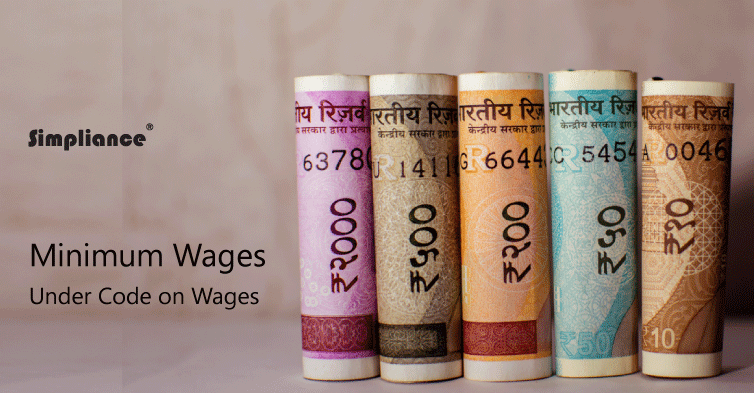
Introduction
The Code on Wages, 2019 subsumes the Minimum Wages Act, 1948 which is the existing enactment regulating and ensuring that workers have a basic standard of life secured through wages that meet their needs. It divides workers into different classes of work known as scheduled employments under the Act and provided for employment-specific minimum wages. The procedure for determining the rate of minimum wage is based on a cost-of-living index number. Minimum wages included all remuneration for work as well as the house-rent allowance afforded to workers, it excludes other emoluments such as travelling allowance, gratuity, contributions etc. from its scope.[s21]
The Act underwent several amendments at the State level that introduced changes and additional compliance requirements. Chapter-II of the Code on Wages, 2019 provides for the law relating to minimum wages. Section-5 thereunder states that no employer shall pay to any employee, wages less than the minimum rate of wages notified by the appropriate Government. The subsequent section shall delve into how minimum wages are going to be fixed.
Reptakos Brett and Fixation of Minimum Wages
To understand how minimum wages are fixed under the Code, we must examine the Apex Court’s decision in the case of Workmen Represented by Secretary vs. Management of Reptakos Brett. This case involved a dispute between a company and its workmen with regards to restructuring of dearness allowance. A division bench of the Supreme Court dealt with this issue and explained the concept and components of minimum wage.
The court referred to the findings of the Tripartite Committee of the Indian Labour Conference, 1957 that provided for five norms for the fixation of minimum wage, they are as follows:
(I) Three consumption units for one earner, excluding the earnings of women, children, and adolescents
(ii) Minimum food requirement based on net intake calories
(iii) Clothing requirement at 72 yards per annum for an average working family of four;
(iv) House rent corresponding to minimum area provided for under the Government’s Industrial Housing Scheme;
(v) 20% of the total minimum wage for fuel, lighting, and miscellaneous items
The court examined the above and stated that a sixth aspect must be included keeping in mind the socio-economic aspect of wage structure. The sixth component would be children’s education, medical requirement, minimum recreation that includes festivals/ceremonies and provisions for old age, marriages etc. and should constitute 25% of the total minimum wage.
It is based on the above decision that the manner for fixation of minimum wages under Rule-3 of the draft Code on Wages (Central) Rules, 2020 have been fixed. The quantum under each of the above heads have been increased and thus the criteria for fixing minimum wages have been established in consonance with contemporary circumstances, as follows:-
(i) The standard working-class family which includes a spouse and two children apart from the earning worker; an equivalent of three adult consumption units
(ii) A net intake of 2700 calories per day per consumption unit
(iii) 66 meters of cloth per year per standard working-class family
(iv) House rent expenditure to constitute 10 percent of food and clothing expenditure
(v) Fuel, electricity, and other miscellaneous items of expenditure to constitute 20% of minimum wage
(vi) Expenditure for children’s education, medical requirement, recreation and expenditure on contingencies to constitute 25% of minimum wage
It is based on the above that minimum wages shall be fixed under the Code on Wages, 2019. The Central Government shall divide every concerned geographical area into metropolitan area, non-metropolitan area, and rural area to fix the minimum rate of wages. As per Rule-5 of the draft Rules, the time interval for revision of dearness allowance has been fixed at once before 1st April and then before 1st October every year[s22].
National Floor Wage
Section-9 of the Code on Wages, 2019 empowers the Central Government to fix a floor wage after considering the minimum living standards of a worker. Although the provision says national floor wage, practical circumstances dictate that a uniform floor wage would create problems as the cost-of-living and living standards differ greatly from one region to another. This is why the proviso to Section-9(1) states that different floor wage may be fixed for different geographical areas. The intent behind fixing floor wage is to ensure that minimum wages that are fixed according to the procedure explained in the preceding section, do not fall below the floor wage for a particular geographical area.
National floor wages shall be fixed after consultation with the Central Advisory Board consisting of persons nominated by the Central Government. The advice tendered by the Central Board shall be circulated to the State Governments for further consultation based on which floor wages shall be fixed and revised at an interval not exceeding five years.
Unskilled, Skilled, Semi-Skilled and Highly Skilled Workers
These are categories of workmen who are divided on account of their skill for fixation of minimum wages. Section-6(6)(a) of the Code on Wages specifies that the appropriate Government shall take the skill of workers into account for fixing minimum wages. The terms have not been defined under the Code but are defined under the draft Central rules for the same.
A highly skilled occupation is one whose performance requires a specific level of perfection and competence that is acquired through intensive technical or professional training or practical occupational experience. More notably, the definition states that an employee in a highly-skilled occupation is required to assume full responsibility for his judgement and decision-making.
A skilled occupation is one which involves skill and competence in its performance through experience on the job or training as an apprentice in a technical or vocational institute. The performance of a skilled occupation involves initiating and judgement.
A semi-skilled occupation is one whose performance requires the application of skill gained by experience on the job. This skill must be applied under the supervision of a skilled employee and includes supervision over the unskilled occupation.
An unskilled occupation is one which merely requires the application of operating experience and involves no further skills.
As part of the procedure of fixing minimum wages, a technical committee shall categorize occupations of employees into the four above-mentioned categories by modifying, deleting, or adding an entry in Schedule-E of the Rules. The Schedule contains a comprehensive list of occupations under each of the four heads. The objective is to ensure that minimum wages are commensurate with the level of skill. This has the added benefit of creating incentives for employees in unskilled or semi-skilled employments to upskill and thus receive better pay.
If you have any doubts or queries about the revised scheme of minimum wages under the Code on Wages, 2019 feel free to drop them in the comments below.
| Disclaimer: This blog is meant for informational purposes and discussion only. It contains only general information about legal matters. The information provided is not legal advice and should not be acted upon without seeking proper legal advice from a practicing attorney. Simpliance makes no representations or warranties in relation to the information on this article. |



Can we split the notified mw under new code into any excluded allowances like hra, conveyance etc?
Hi,
That is subject to Government regulations, we cannot answer definitively right now
Regards
Animay